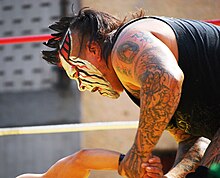CMLL Mini-Estrellas Tournaments
| Torneo de Parejas Increibles | ||||
|---|---|---|---|---|

Official poster for the show, advertising the Torneo de Parejas Increibles
|
||||
| Information | ||||
| Promotion | Consejo Mundial de Lucha Libre | |||
| Date | August 21, 2011 | |||
| Venue | Arena Mexico | |||
| City | Mexico City, Mexico | |||
| Event chronology | ||||
|
||||
| Torneo Bicentenario de Mini-Estrellas | ||||
|---|---|---|---|---|

Demus 3:16, winner of the tournament and promoted to the "Regular" division
|
||||
| Information | ||||
| Promotion | Consejo Mundial de Lucha Libre | |||
| Date | August 10, 2010 to August 24, 2010 | |||
| Venue | Arena Mexico | |||
| City | Mexico City, Mexico | |||
| Event chronology | ||||
|
||||
| Infierno en el Ring (2012) | ||||
|---|---|---|---|---|

Poster for the 12 Mini-Estrellas cage match
|
||||
| Information | ||||
| Promotion | Consejo Mundial de Lucha Libre | |||
| Date | November 6, 2012 | |||
| Venue | Arena Mexico | |||
| City | Mexico City, Mexico | |||
| Event chronology | ||||
|
||||
The Mexican professional wrestling promotion Consejo Mundial de Lucha Libre (CMLL) has held a number of tournaments for their Mini-Estrella division since it was founded in 1992, some recurring and others a one off tournament held for a special event. Being professional wrestling tournaments, it they are not won legitimately; they are instead won via predetermined outcomes to the matches that is kept secret from the general public. The Mini-Estrella division has been featured in a Ruleta de la Muerte (Spanish for "Roulette of Death") tournament. A Ruleta de la Muerte tournament is a tournament in which tag teams face off in a single elimination tournament, but unlike traditional tournaments it is the losing team that advances in the tournament. The team that loses the tag team match final must immediately wrestle against each other in a Lucha de Apuestas match, where either their mask or their hair is on the line. In 2010 CMLL held a Mini-Estrella focused Torneo Bicentenario, celebrating the 200th anniversary of Mexico's independence, a tournament where the winning Mini-Estrella would be "Promoted" to the regular sized male division and compete on equal footing in CMLL. The movement from Mini-Estrella to "Regular" competitor is rare in Lucha Libre, but not without precedent as CMLL themselves held such a match in 1997, but this marked the first time a Mini-Estrella was openly promoted to the regular division without changing their ring persona or moving to a different wrestling promotion.
In late 1997 CMLL held an eight-man Torneo cibernetico elimination match where the winner would earn the right to work in the "regular sized" division instead of the Mini-Estrella division. This move was possible due to the fact that not all wrestlers competing in the Mini-Estrellas division have dwarfism, as is the case with Midget professional wrestling practiced outside Mexico. Originally the Mini-Estrella division had a height limit of 1.53 m (5 ft 0 in), although wrestlers such as Pequeño Olímpico work the Minis division despite being 1.69 m (5 ft 6 1⁄2 in) tall. The match included most of CMLL's Mini-Estrellas division, a division that was not very active nor very visible on CMLL shows and included Damiancito El Guerrero (who held the CMLL World Mini-Estrella Championship at the time), Cicloncito Ramírez, Tritoncito, Pequeño Cochisse, Platita, Guerrerito del Future, Pequeño Sayama and Fierito. Damiancito del Guerrero was the last competitor in the ring, earning the right to move into the regular division. At 1.65 m (5 ft 5 in), above the Mini-Estrella height limit, CMLL felt that the talented wrestler had more value in the regular division than the highly inactive Mini-Estrellas division.
...
Wikipedia
